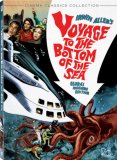Synopsis
When Admiral Walter Pidgeon’s glass-nosed submarine (?) Seaview surfaces at the North Pole after an extended stay underwater, Pidgeon and crew discover the sky is on fire. It turns out the Van Allen radiation belt has caught fire (?!) and life on Earth will be incinerated once the temperature reaches 175 Farenheit (and not, apparently, a single degree less). Pidgeon and co-hort Peter Lorre come up with a plan to launch a nuclear missile into the belt and use the explosion to blow out …he fire (??!!). The UN scientists think they’re made, and subs are dispatched to stop the Seaview as it makes a desperate journey to the reach the correct location and time to launch the missile. On top of everything else, there’s a saboteur aboard.
For some reason, there appears to be a real attempt to convince viewers that this is some kind of SF classic. Let’s be clear: it is not. It has entertainment value, but this is largely because of its colossal stupidity. It is one of the most preposterous, ridiculous movies ever made (by comparison, The Day After Tomorrow is a sober documentary), but what else can one expect from producer/director/co-writer Irwin Allen? The Poseidon Adventure, The Towering Inferno and The Swarm were still in Allen’s future in 1961, but the ham-fisted attempts at characterization, vulgar spectacle and idiotic plots are already in place. See! Ice that sinks! See! Actors swimming around in what looks more like a aquarium than the ocean! See! The same effects shots of the sub over and over and over again! Pidgeon recycles his patented Man With More Authority Than God role (Morgan Freeman would be perfect for the role in a remake), but poor Lorre has nothing to do except stand around and look disgusted with the script. Have some pity, too, for future “I Dream of Jeannie” star Barbara Eden as Pidgeon’s secretary and Captain Robert Sterling’s girlfriend. Her role seems to consist entirely of running after Sterling and calling his name.
Audio
The situation isn’t quite a fiasco, but it’s on its way there. The options are 4.0 and 2.0 surround. Neither is satifactory. The former is clear and clean, but a bit thin and might as well be mono. In fact, it has no surround presence at all. The 2.0 version has plenty of that, and has a nice big sound, but the dialogue is horrifically distorted, sounding as if it had been recorded inside a brass echo chamber. The effect is so distracting that the track is unlistenable. The 4.0 is deeply unexciting, but at least it isn’t actively hostile.
Video
The picture, fortunately, is much better. Though it is sometimes a little bit soft, generally it looks very good. The print is in excellent shape, and the colours are superb, going a long way toward giving the movie whatever excitement it might have (ersatz though it may be). There is no damage to the print, and grain is minimal.
Special Features
Tim Colliver’s commentary is cheerful and informative. He does acknowledge some of the sillier aspects of the film, though I still think he gives the flick more credit than it deserves. “Science Fiction: Fantasy to Reality” is a documentary about the prophetic nature of SF films, and tries to make us believe that this pic is an uncanny look forward to global warming, a claim that is roughly equivalent to drawing serious comparisons between The Towering Inferno and 9/11. There are a clutch of short interviews with Eden (who thinks Irwin Allen was a helluva guy). The galleries are devoted to the original props, production art, production stills, posters, lobby cards, and the exhibitor’s campaign manual. And you have your isolated score track. The liner notes continue the campaign to promote the movie as a forward-looking classic “as closes as possible to scientific fact.” Right. And icebergs sink.
Closing Thoughts
As submarine movies go, this might be the dumbest. Fun to watch in an MST3K sort of way, though.
Special Features List
- Audio Commentary
- “Sciende Fiction: Fantasy to Reality” Documentary
- Interview with Barbara Eden
- Still Galleries
- Original Props
- Exhibitor’s Campaign Manual
- Isolated Score Track
- Liner Notes






07/09/2007 @ 11:13 pm
Tim Colliver’s commentary track is one of the worst of such “extras” I have ever found. He comes off as a happy-talking but empty-headed DJ who is ad-libbing his commentary and just filling time. A few interesting anecdotes make it into his otherwise boring and surprisingly sparse monologue. Colliver pulls a few gaffs, too – he mispronounces “depth” as “dep” twice, makes numerous grammatical errors, fails to distinguish between concave and convex lenses, and says he feels obligated to point out the differences between the movie and the novelization… and vice versa! On the other hand, the isolated music track is dramatic and well-recorded. Some of the tracks were used in the first season of the Voyage TV series and can be heard here. But unlike the isolated music track on the new release of Fantastic Voyage, dialog is not heard where the orchestra is silent, leaving very long periods of screen action with no sound whatsoever.I did not pull out the previous edition of Voyage to the Bottom of the Sea on a two-sided disk with Fantastic Voyage to compare the video quality, but for my money, this “Global Warming” edition is not worth the expenditure.